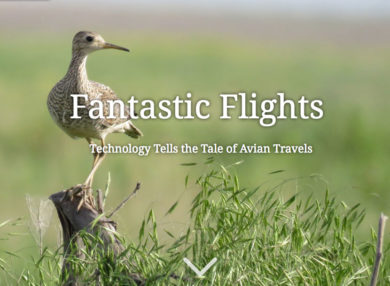Across great distances they migrate—from the prairies, hayfields, and plains of North America to the arid grasslands of Mexico and the pampas and fields of South America. Migratory grassland birds spend nearly three-quarters of their lives away from their breeding grounds, yet we know relatively little about this time in their lives. We cannot truly conserve and manage migratory bird populations until we understand the processes affecting them during the migration and non-breeding periods.
VCE is discovering the migration routes and wintering sites for four migratory grassland bird species: Upland Sandpiper, Grasshopper Sparrow, Eastern Meadowlark, and Bobolink. To track them in migration, we're fitting birds with satellite tags and high-tech miniature backpacks called geolocators.
Geolocators record sunlight levels and the satellite tags communicate with the Global Positioning System (GPS) satellites—both types of tags allow us to determine where a bird has been for an entire year across its breeding, wintering, and migratory range. These lightweight tracking devices are powerful new tools for bird conservation, and VCE and the U.S. Department of Defense (DoD) Legacy Program are partnering together to protect at-risk grassland bird species on military lands across the U.S. In 2015, we launched a multi-year research project for grassland birds on six military installations in six states–from North Dakota to Massachusetts. The outcomes of this research project will illuminate a full life-cycle approach to conserving grassland bird populations across the U.S.
- Grasshopper Sparrow – How do you follow a 17-gram secretive bird for a year? Geolocators. Generally silent outside of the breeding season, Grasshopper Sparrows spend most of their time on the ground and are infrequently seen on their migratory routes and wintering grounds. Consequently, the non-breeding season movements of Grasshopper Sparrows are not well elucidated, but geolocators will help change that. In 2015 we deployed 180 geolocators on Grasshopper Sparrows, and in 2016 we recovered 35 these devices to learn about their seasonal movements. The data will help us learn about “population connectivity”—the degree to which Grasshopper Sparrows mix or separate into distinct breeding and wintering sites—which has implications for long-term conservation.
- Upland Sandpiper – This prairie shorebird, a long-distance migrant, is declining across the Northeast and in other parts of the country. Our preliminary 2015 field season was a great success, and in 2016 satellite tags helped us determine when and where these sandpipers migrate and where they overwinter. Satellite tags send data back to us remotely, eliminating the need for us to recapture a tagged individual. We often think of migration as the simplistic and simple movement from the breeding grounds to the wintering grounds. In reality, however, individual Upland Sandpipers may hopscotch between many grasslands during migration, and their wintering area may consist of many discrete grasslands.
- Eastern Meadowlark – Eastern Meadowlarks populations are migratory across the northern portion of their range, and they have declined across the U.S. by 80% over the last 50 years. As populations shrink they may become more isolated from each other, as fewer individuals move between populations. The resulting small populations may have reduced genetic diversity and they may be more vulnerable to population fluctuations from severe weather and depredation. The satellite tags we deployed on meadowlarks in 2016 are shedding light on the different migration strategies and routes used by Eastern Meadowlarks.
- Bobolink – Before VCE’s project work with DoD began, our groundbreaking Bobolink migration research revealed the migratory pathways of Bobolinks and shed light onto the role that Bobolinks play in bringing avian parasites to the Galapagos Islands.


